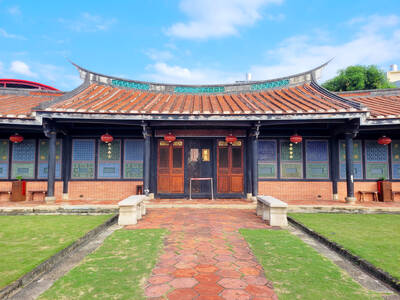This year is a special one for the Taiwan POW Camps Memorial Society — Aug. 15 marked the 75th anniversary of VJ Day, the Allied victory over Japan and the end of World War II. Only then were the surviving men held in the 14 POW camps across Taiwan able to go free. More than 4,350 Allied servicemen were held in harrowing conditions in these camps, with records showing that at least 430 did not make it to see VJ Day.
According to the society’s Web site, if the war hadn’t ended when it did, “it is certain that most — if not all, of the Taiwan POWs would have died.”
Society founder Michael Hurst held the first service for the POWs in 1997, and that November, the first memorial for them was erected at the site of the former Kinkaseki Camp in New Taipei City’s Jinguashi (金瓜石). They will be hosting their annual Remembrance Day event on Nov. 15 at the memorial, followed by a picnic lunch at the community center.

Photo: Han Cheung, Taipei Times
Due to the COVID-19 pandemic, everyone who plans to attend this year must pre-register with the New Zealand Commerce & Industry Office, regardless of whether they plan on taking the shuttle bus or not. Face masks are also mandatory and will not be provided. Registration must be completed before 5pm on Wednesday.
■ Nov. 15 at 11am at Taiwan POW Memorial Park in Jinguashi, New Taipei City. Buses will depart from Grand Hyatt Hotel, 2 Songshou Rd, Taipei City (台北市松壽路2號) at 9:15am.
■ Contact Joyce Hu at the New Zealand Commerce & Industry Office in Taipei to pre-register at (02) 2720-5228, ext 3606, or e-mail joyce.hu@mfat.govt.nz
■ Bus and lunch is NT$500, for more information visit www.powtaiwan.org

Last week saw the appearance of another odious screed full of lies from the People’s Republic of China (PRC) Ambassador to Australia, Xiao Qian (肖千), in the Financial Review, a major Australian paper. Xiao’s piece was presented without challenge or caveat. His “Seven truths on why Taiwan always will be China’s” presented a “greatest hits” of the litany of PRC falsehoods. This includes: Taiwan’s indigenous peoples were descended from the people of China 30,000 years ago; a “Chinese” imperial government administrated Taiwan in the 14th century; Koxinga, also known as Cheng Cheng-kung (鄭成功), “recovered” Taiwan for China; the Qing owned

Jan. 20 to Jan. 26 Taipei was in a jubilant, patriotic mood on the morning of Jan. 25, 1954. Flags hung outside shops and residences, people chanted anti-communist slogans and rousing music blared from loudspeakers. The occasion was the arrival of about 14,000 Chinese prisoners from the Korean War, who had elected to head to Taiwan instead of being repatriated to China. The majority landed in Keelung over three days and were paraded through the capital to great fanfare. Air Force planes dropped colorful flyers, one of which read, “You’re back, you’re finally back. You finally overcame the evil communist bandits and

I am kneeling quite awkwardly on a cushion in a yoga studio in London’s Shoreditch on an unseasonably chilly Wednesday and wondering when exactly will be the optimum time to rearrange my legs. I have an ice-cold mango and passion fruit kombucha beside me and an agonising case of pins and needles. The solution to pins and needles, I learned a few years ago, is to directly confront the agony: pull your legs out from underneath you, bend your toes up as high as they can reach, and yes, it will hurt far more initially, but then the pain subsides.

When 17-year-old Lin Shih (林石) crossed the Taiwan Strait in 1746 with a group of settlers, he could hardly have known the magnitude of wealth and influence his family would later amass on the island, or that one day tourists would be walking through the home of his descendants in central Taiwan. He might also have been surprised to see the family home located in Wufeng District (霧峰) of Taichung, as Lin initially settled further north in what is now Dali District (大里). However, after the Qing executed him for his alleged participation in the Lin Shuang-Wen Rebellion (林爽文事件), his grandsons were